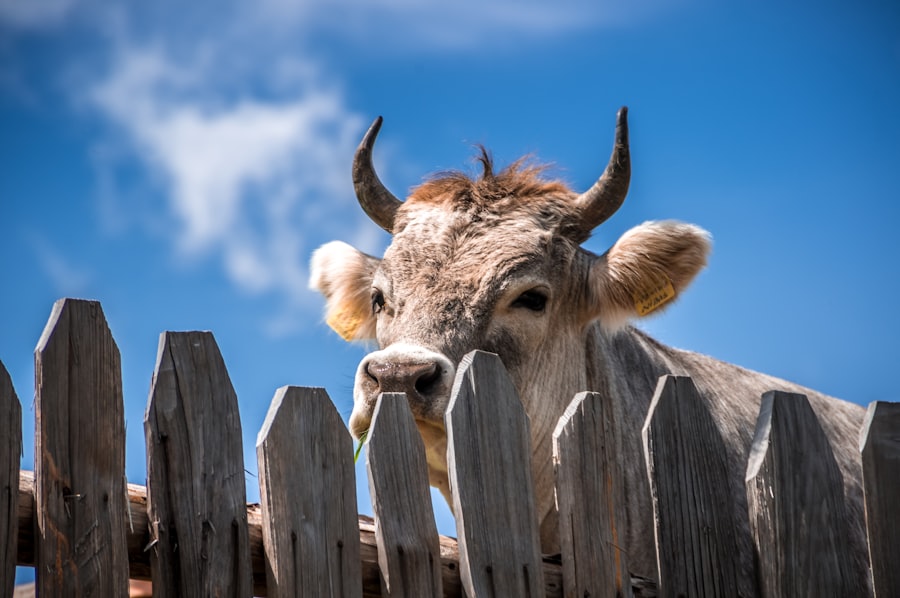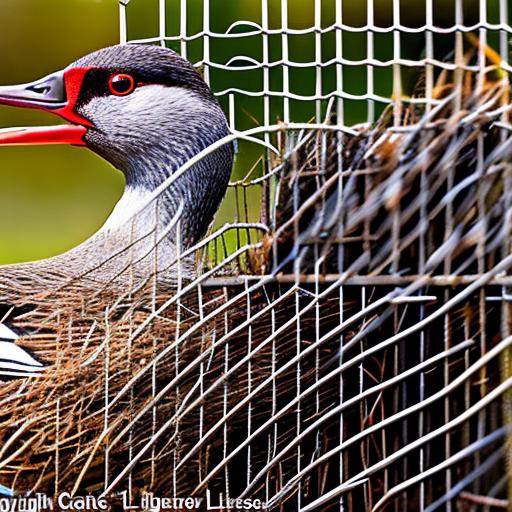Geese intrusion on properties has become a growing concern for many homeowners and property owners. These birds, known for their large size and aggressive behavior, can cause significant damage to lawns, gardens, and other outdoor areas. Additionally, their droppings can create unsightly messes and pose health risks to humans and pets. The negative impact of geese on the environment is also a concern, as they can disrupt ecosystems and contribute to water pollution.
Key Takeaways
- Geese intrusion can cause damage to property and pose health risks.
- Installing a fence is an effective way to keep geese out and protect your property.
- Choose a fence that is tall, sturdy, and has small gaps to prevent geese from entering.
- Proper planning and preparation are important for successful fence installation.
- Regular maintenance is necessary to ensure long-term effectiveness of the fence.
The Benefits of Installing a Fence to Keep Geese Out
One effective solution to keep geese away from your property is to install a fence. A fence acts as a physical barrier that prevents geese from accessing your property. By creating a boundary, you can effectively deter geese from entering your space and causing damage.
There are several benefits to having a fence to keep geese out. Firstly, it protects your property from damage caused by geese. Geese are known to graze on grass and vegetation, which can result in bare patches and unsightly lawns. By installing a fence, you can preserve the beauty of your property and maintain its value.
Secondly, a fence helps protect the environment. Geese can disrupt ecosystems by overgrazing on vegetation and disturbing nesting sites of other bird species. By keeping geese out with a fence, you can help maintain the balance of local ecosystems and protect native wildlife.
Choosing the Right Type of Fence for Your Property
When choosing a fence to keep geese out, it’s important to consider the different types available and their pros and cons. Here are some common types of fences that are effective in deterring geese:
1. Chain-link fence: A chain-link fence is a popular choice for keeping geese out due to its durability and affordability. The small gaps in the chain-link mesh make it difficult for geese to pass through. However, it’s important to ensure that the fence is tall enough to prevent geese from flying over it.
2. Electric fence: An electric fence can be an effective deterrent for geese. The mild electric shock that it delivers when touched by a bird discourages geese from attempting to cross the barrier. However, it’s important to follow local regulations and ensure that the fence is installed correctly to avoid harm to wildlife or humans.
3. Wooden fence: A wooden fence can also be effective in keeping geese out. The solid structure of a wooden fence makes it difficult for geese to pass through or fly over. However, it’s important to choose a fence design that does not have large gaps between the boards, as geese may be able to squeeze through.
Planning and Preparing for Fence Installation
Before installing a fence to keep geese out, it’s important to plan and prepare for the installation process. This involves considering factors such as the size and layout of your property, local regulations, and budget.
Firstly, measure the perimeter of your property to determine the amount of fencing material needed. Consider any obstacles or uneven terrain that may require additional planning or adjustments during installation.
Next, check with your local authorities regarding any permits or regulations that may apply to fence installation in your area. Some areas may have specific height restrictions or setback requirements that need to be followed.
Lastly, consider your budget for the project. Fencing materials can vary in cost, so it’s important to choose a type of fence that fits within your budget while still meeting your needs.
Installing a Fence: Step-by-Step Guide
Installing a fence to keep geese out can be done as a DIY project with the right tools and materials. Here is a step-by-step guide on how to install a fence:
1. Mark the perimeter: Use stakes and string to mark the perimeter of your property where the fence will be installed.
2. Dig post holes: Use a post hole digger to dig holes for the fence posts. The depth of the holes will depend on the height of the fence and the type of soil in your area.
3. Install the posts: Place the fence posts in the holes and fill them with concrete or gravel to secure them in place. Ensure that the posts are level and evenly spaced.
4. Attach the rails: Once the posts are secure, attach the rails to create the framework of the fence. This can be done using screws or nails.
5. Install the fencing material: Depending on the type of fence chosen, install the fencing material by attaching it to the rails. This may involve weaving chain-link mesh, attaching wooden boards, or connecting electric wires.
6. Secure the fence: Ensure that all connections are secure and tighten any loose screws or nails. Test the stability of the fence by applying pressure to different sections.
7. Add finishing touches: If desired, add any finishing touches such as paint or stain to protect and enhance the appearance of the fence.
Maintaining Your Fence for Long-Term Effectiveness

To ensure that your fence remains effective in keeping geese out, regular maintenance is necessary. Here are some maintenance tips to keep your fence in good condition:
1. Inspect regularly: Regularly inspect your fence for any signs of damage or wear. Look for loose screws or nails, broken boards, or sagging sections.
2. Repair promptly: If you notice any damage, repair it promptly to prevent further deterioration. Replace any broken boards or tighten loose connections.
3. Clean regularly: Clean your fence regularly to remove dirt, debris, and bird droppings. This can be done using a hose or pressure washer.
4. Trim vegetation: Trim any vegetation near your fence that may provide a landing spot for geese or obstruct the fence. This will help maintain the effectiveness of the fence as a deterrent.
5. Apply protective coatings: Depending on the type of fence, applying protective coatings such as paint or stain can help prolong its lifespan and protect it from the elements.
Alternative Methods to Keep Geese Away from Your Property
While installing a fence is an effective method to keep geese out, there are also alternative methods that can be used. Here are some other methods to consider:
1. Scare tactics: Using scare tactics such as decoys, noise makers, or motion-activated sprinklers can deter geese from entering your property. However, these methods may not be as effective in the long term and may require regular maintenance.
2. Landscaping modifications: Modifying your landscaping can make your property less attractive to geese. This can include removing or reducing areas of open grass, planting tall shrubs or trees near water sources, or installing floating barriers in ponds or lakes.
3. Habitat modification: Geese are attracted to areas with easy access to food and water. By modifying the habitat to make it less appealing, such as removing food sources or draining standing water, you can discourage geese from staying on your property.
Common Mistakes to Avoid When Fencing for Geese
When installing a fence to keep geese out, it’s important to avoid common mistakes that can compromise its effectiveness. Here are some mistakes to avoid:
1. Choosing the wrong height: Ensure that the height of your fence is appropriate for deterring geese. Geese are capable of flying over low fences, so it’s important to choose a height that prevents them from doing so.
2. Neglecting maintenance: Regular maintenance is crucial for keeping your fence in good condition and ensuring its long-term effectiveness. Neglecting maintenance can result in damage or deterioration that may allow geese to enter your property.
3. Ignoring local regulations: Before installing a fence, it’s important to check with your local authorities regarding any permits or regulations that may apply. Ignoring these regulations can result in fines or the need to remove or modify the fence.
Legal Considerations for Fencing in Your Area
When installing a fence to keep geese out, it’s important to consider the legal aspects of fencing in your area. This may include obtaining permits or following specific regulations. Here are some legal considerations to keep in mind:
1. Permits: Some areas may require permits for fence installation, especially if the fence exceeds a certain height or if it is located near a property line. Check with your local authorities to determine if a permit is required.
2. Setback requirements: Setback requirements refer to the distance that a fence must be set back from property lines or public rights-of-way. These requirements vary by location, so it’s important to ensure that your fence meets the setback requirements in your area.
3. Homeowners’ association rules: If you live in a community with a homeowners’ association (HOA), there may be specific rules and regulations regarding fence installation. Check with your HOA to ensure that your fence complies with their guidelines.
Protecting Your Property and the Environment from Geese Intrusion
In conclusion, geese intrusion on properties can cause significant damage and pose risks to both the environment and property owners. Installing a fence is an effective solution to keep geese out and protect your property from damage. By choosing the right type of fence, planning and preparing for installation, and maintaining the fence properly, you can create a barrier that deters geese from entering your space.
It’s also important to consider alternative methods and avoid common mistakes when fencing for geese. Additionally, be aware of the legal considerations that may apply in your area when installing a fence.
By taking action to protect your property and the environment from geese intrusion, you can maintain the beauty and value of your property while preserving local ecosystems.
If you’re looking for effective ways to keep geese out of your property, fencing is a tried and tested method. However, it’s important to ensure that your fence is properly designed and constructed to effectively deter these persistent birds. In a related article on Poultry Wizard, you can find valuable insights on how to build a secure fence that will keep geese at bay. From choosing the right materials to determining the ideal height and spacing, this article provides practical tips and guidelines for creating a goose-proof barrier. Check out the article here to learn more about fencing solutions for keeping geese away from your property.
Meet Walter, the feathered-friend fanatic of Florida! Nestled in the sunshine state, Walter struts through life with his feathered companions, clucking his way to happiness. With a coop that’s fancier than a five-star hotel, he’s the Don Juan of the chicken world. When he’s not teaching his hens to do the cha-cha, you’ll find him in a heated debate with his prized rooster, Sir Clucks-a-Lot. Walter’s poultry passion is no yolk; he’s the sunny-side-up guy you never knew you needed in your flock of friends!







